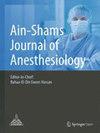Anesthetic management for renal transplant in patients with grade III diastolic dysfunction: case reports
IF 0.5
Q4 ANESTHESIOLOGY
引用次数: 0
Abstract
Abstract Background Left ventricular diastolic dysfunction is frequently noticed in patients with multiple co-morbidities. Echocardiography is used to determine the presence of diastolic dysfunction and to grade its severity. In left ventricular diastolic dysfunction, the ventricular diastolic distensibility, filling, or relaxation is abnormal; however, the left ventricular ejection fraction may be normal or decreased. Case presentation We present anesthetic management of two patients with diastolic dysfunction grade III for renal transplant. During declamping in renal transplant, high central venous pressures are required for adequate perfusion of the transplanted kidney. In the operation theater standard monitors including NIBP, SpO 2 and five lead ECG were attached. An arterial line (radial) and central line (right internal jugular) were established for IBP and CVP monitoring. Infusions of furosemide and dopamine were started. Nitrogycerine and milrinone infusions were prepared but were not required intraoperatively. Both the patients were extubated at the end of surgery. Conclusions Increased incidence of major adverse cardiovascular events has been reported in surgical patients having grade III diastolic dysfunction. Hemodynamic instability and fluid overload in this set of patients are known to generate pulmonary edema.III级舒张功能不全患者肾移植的麻醉管理:病例报告
背景左室舒张功能不全常出现在多种合并症患者中。超声心动图用于确定是否存在舒张功能障碍并对其严重程度进行分级。左室舒张功能不全时,心室舒张度、充盈或舒张异常;然而,左心室射血分数可能正常或降低。我们报告两例肾移植患者III级舒张功能不全的麻醉处理。在肾移植去钳过程中,需要高中心静脉压来保证移植肾的充分灌注。在手术室中附标准监护仪,包括NIBP、spo2和五导联心电图。建立动脉线(桡动脉)和中心线(右颈内静脉)监测IBP和CVP。开始滴注速尿和多巴胺。准备了硝基甘油和米立酮输注,但术中不需要。手术结束时,两例患者均拔管。结论:有报道称,III级舒张功能不全手术患者的主要不良心血管事件发生率增加。已知这组患者的血流动力学不稳定和液体超载会产生肺水肿。
本文章由计算机程序翻译,如有差异,请以英文原文为准。
求助全文
约1分钟内获得全文
求助全文

 求助内容:
求助内容: 应助结果提醒方式:
应助结果提醒方式:


